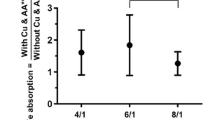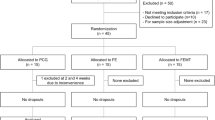Abstract
In the human gastrointestinal tract, trypsin and mucin may affect the absorption of heme iron. However, these interactions have not been well-established. We determined the effect of trypsin and mucin on heme iron absorption in humans. Design: Twenty-eight apparently healthy females participated in two studies (14 per study). Study A evaluated the effect of trypsin on iron bioavailability. Subjects ingested 100 mg trypsin and 1.7 g mucin on 5 mg heme iron bioavailability on days 1, 2, 14, and 15, respectively. In study B, which assessed the effect of mucin on heme iron bioavailability, the subjects ingested hemin, hemin plus mucin, hemoglobin (Hb), and Hb plus mucin, on days 1, 2, 14, and 15, respectively. Results: In study A, the geometric means ± 1 SD of heme iron absorption were 5.1 % (3.1–8.3), 2.9 % (1.6–5.1), 7.3 % (4.1–13.1), and 6 % (2.7–13) for hemin, hemin plus trypsin, Hb plus trypsin, and Hb plus mucin plus trypsin, respectively. In study B, the geometric means ± 1 SD of heme iron absorption were 16.4 % (10.5–25.7), 13.1 % (9.0–18.9), 13.7 % (9.0–20.7), and 11.8 % (7.6–18.3) for hemin, hemin plus mucin, Hb, and Hb plus mucin, respectively. The ratio increased when Hb plus trypsin was ingested and decreased when hemin plus trypsin was ingested. There were no differences in other ratios with respect to the ratio on day 1 (P < 0.05). Conclusion: Trypsin is the only human gastrointestinal protein that evaluated the affects of heme iron absorption. However, this effect depends on how heme iron is ingested.

Similar content being viewed by others
References
Sharp P, Srai SK (2007) Molecular mechanisms involved in intestinal iron absorption. World J Gastroenterol 13(35):4716–4724
Layrisse M, Martinez-Torres C, Cook JD, Walker R, Finch CA (1973) Iron fortification of food: its measurement by the extrinsic tag method. Blood 41(3):333–352
Hurrell RF, Juillerat MA, Reddy MB, Lynch SR, Dassenko SA, Cook JD (1992) Soy protein, phytate, and iron absorption in humans. Am J Clin Nutr 56(3):573–578
Hallberg L, Brune M, Erlandsson M, Sandberg AS, Rossander-Hulten L (1991) Calcium: effect of different amounts on nonheme- and heme-iron absorption in humans. Am J Clin Nutr 53(1):112–119
Disler PB, Lynch SR, Torrance JD, Sayers MH, Bothwell TH, Charlton RW (1975) The mechanism of the inhibition of iron absorption by tea. S Afr J Med Sci 40(4):109–116
Disler PB, Lynch SR, Charlton RW, Torrance JD, Bothwell TH, Walker RB, Mayet F (1975) The effect of tea on iron absorption. Gut 16(3):193–200
Cook JD, Morck TA, Lynch SR (1981) The inhibitory effect of soy products on nonheme iron absorption in man. Am J Clin Nutr 34(12):2622–2629
Martinez-Torres C, Leets I, Renzi M, Layrisse M (1974) Iron absorption by humans from veal liver. J Nutr 104(8):983–993
Atallah AN, Hofmeyr GJ, Duley L (2000) Calcium supplementation during pregnancy for preventing hypertensive disorders and related problems. Cochrane Database Syst Rev (2):CD001059
Hallberg L, Bjorn-Rasmussen E, Howard L, Rossander L (1979) Dietary heme iron absorption. A discussion of possible mechanisms for the absorption-promoting effect of meat and for the regulation of iron absorption. Scand J Gastroenterol 14(7):769–779
Jin F, Welch R, Glahn R (2006) Moving toward a more physiological model: application of mucin to refine the in vitro digestion/Caco-2 cell culture system. J Agric Food Chem 54(23):8962–8967
Uc A, Stokes JB, Britigan BE (2004) Heme transport exhibits polarity in Caco-2 cells: evidence for an active and membrane protein-mediated process. Am J Physiol Gastrointest Liver Physiol 287(6):G1150–G1157
Asenjo J, Amar M, Cartagena N, King J, Hiche E, Stekel A (1985) Use of a bovine heme iron concentrate in the fortification of biscuits. J Food Sci 50:795–799
Labbe RF, Nishida G (1957) A new method of hemin isolation. Biochim Biophys Acta 26(2):437
Flowers CA, Kuizon M, Beard JL, Skikne BS, Covell AM, Cook JD (1986) A serum ferritin assay for prevalence studies of iron deficiency. Am J Hematol 23(2):141–151
WHO, CDC (2007) Report of a Joint World Health Organization/Centers for Disease Control and Prevention Technical Consultation on the Assessment of Iron Status at the Population Level. WHO, Geneve
WHO (2001) Iron deficiency anaemia assessment, prevention, and control: a guide for programme managers. WHO, Geneve
Eakins JD, Brown DA (1966) An improved method for the simultaneous determination of iron-55 and iron-59 in blood by liquid scintillation counting. Int J Appl Radiat Isot 17(7):391–397
Nadler S, Hidalgo I, Bloch T (1962) Prediction of blood volume in normal human adults. Surgery 51(2):224–232
Bothwell TH, Charlton RW, Cook JD, Finch CA (1979) Iron metabolism in man. Blackwell, Oxford
Lentner C (1981) Geigy scientific tables: units of measurements, body fluids, composition of the body, and nutrition, 8th edn. Ciba Pharmaceutical Co, Basel, Vol. 1
Guyton A, Hall J (2006) Text book of medical physiology, 11th edn. Elsevier, Philadelphia
Conrad ME, Cortell S, Williams HL, Foy AL (1966) Polymerization and intraluminal factors in the absorption of hemoglobin-iron. J Lab Clin Med 68(4):659–668
Perez-Vilar J, Hill RL (1999) The structure and assembly of secreted mucins. J Biol Chem 274(45):31751–31754
Bansil R, Stanley E, LaMont JT (1995) Mucin biophysics. Annu Rev Physiol 57:635–657
Magdanz M (1969) Studies of the structural homology of chymotrypsin and trypsin. University of Washington, Seattle
Acknowledgments
The study was supported by grant 1061060 from Fondo Nacional de Ciencia y Tecnología Chile. We thank Ms. Angélica Letelier for her technical assistance.
Author information
Authors and Affiliations
Corresponding author
Rights and permissions
About this article
Cite this article
Cediel, G., Olivares, M., Gaitán, D. et al. Effect of Trypsin and Mucin on Heme Iron Bioavailability in Humans. Biol Trace Elem Res 150, 37–41 (2012). https://doi.org/10.1007/s12011-012-9483-9
Received:
Accepted:
Published:
Issue Date:
DOI: https://doi.org/10.1007/s12011-012-9483-9




